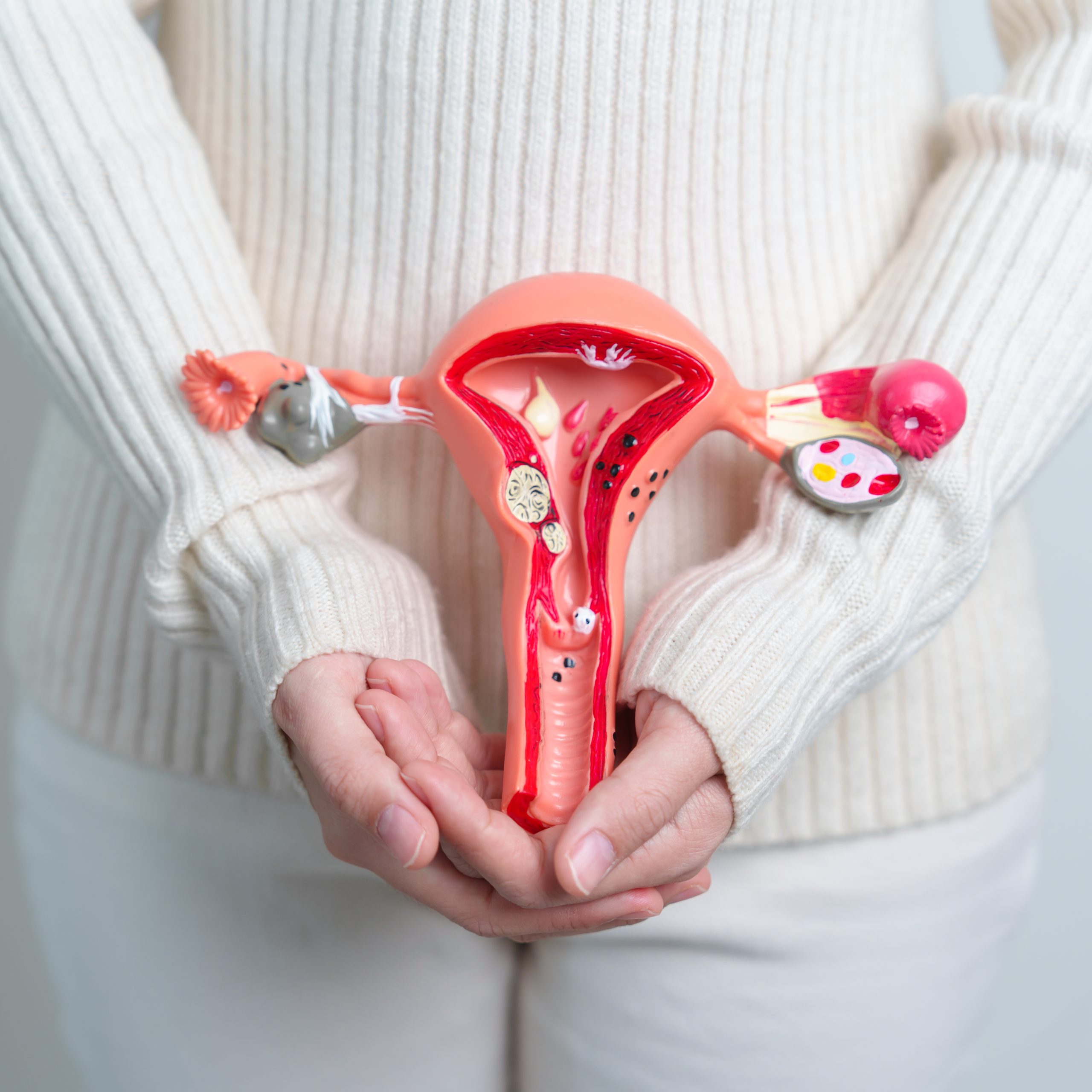Getting your “tubes tied” for permanent birth control.
Are you done having kids and tired of taking birth control? When the family is complete, many couples look for permanent options so they never have to worry about a “surprise” pregnancy. Permanent birth control allows couples to take control of family planning.
For men, vasectomy is a quick and straightforward office procedure to prevent sperm from mixing with semen. The procedure is typically done in an office setting or ambulatory surgical center.
Women may choose the option of laparoscopic tubal surgery. During this outpatient procedure, the fallopian tubes are tied, cut, or removed to prevent pregnancy. Tubal surgeries block the pathway between the uterus and ovaries, preventing sperm from reaching the egg.
Having your tubes tied does not affect your hormones or periods. Hormones come from the ovaries which are not affected by tubal surgeries. The fallopian tubes are located outside of the uterus, so removing them does not change the menstrual cycle’s timing, length, or heaviness.
How is tubal surgery performed?
First, you schedule a visit with your doctor to discuss the risks and benefits and make sure this is the right time for this procedure. The surgery is performed under general anesthesia. By cutting a tiny 5 mm incision, the surgeon places a camera (laparoscope) through your belly button to see the pelvic anatomy.
We inflate the abdomen with air to move the other organs away and allow us to operate safely. One or sometimes two additional small incisions are made off to the side to permit the placement of different ports. Using small instruments, the surgeon will tie, cut, clamp, or remove the fallopian tubes. The air is released from the belly to reduce postoperative pain. After a brief rest in the recovery room, most patients can go home shortly after and return to work in a few days.
What are the risks of tubal surgery?
The most common problem with sterilization procedures is regret. Tubal surgery is permanent, so it is essential that you are 100% sure that you do not want to get pregnant again. Tubal reversal surgeries and in-vitro-fertilization are options for those who desire children after having a previous tubal sterilization procedure.
All surgeries have risks. Any procedure requiring anesthesia may result in an adverse reaction. During any surgery, organs in the surrounding area are at risk. Tubal surgery is an operation where a laparoscope is inserted in the abdominal cavity. Risks associated with tubal procedures include:
- Damage to the surrounding organs such as bowel, bladder or major blood vessels
- Bleeding
- Wound infection
- Failure to prevent pregnancy
- Abdominal pain
- Deep venous thrombosis
- Pelvic adhesions
Where is a tubal surgery performed?
Laparoscopic tubal surgery is performed in an ambulatory surgery center or hospital.
How long will I be in the hospital?
Laparoscopic tubal surgery is an outpatient procedure. You may go home after the operation is complete.
Can my family visit me?
A trusted family member should drive you to and from the appointment. Your family is welcome to stay with you before and after this outpatient procedure.
Does my procedure require an anesthetic?
General anesthesia is required for any laparoscopic surgery. The surgeon may also inject an anesthetic into the incisions to decrease post-operative pain.
What’s the procedure when I check-in?
Most surgeries will involve a preoperative visit with your surgeon to go over the procedure’s risks and benefits in detail. Your surgeon answers questions regarding your upcoming surgery. The surgical consent form is reviewed, signed, or updated with any changes.
Because laparoscopic tubal surgery is considered a permanent form of birth control, your doctor will ask questions to make sure you are confident you will not want children in the future.
In most settings, patients will receive a preoperative phone call by a nurse or medical assistant one to two days before surgery. If any blood work or preoperative testing is required, it will be scheduled and confirmed.
After arrival at the hospital or Ambulatory Surgery Center. The staff will guide you to the preoperative holding area to change into a surgical gown and store your valuables. You will meet the nursing team who will provide care during your stay. An IV will be placed at this time.
The anesthesia team will come to interview you and answer questions. Typically your surgeon will also come and review any last-minute questions.

wavebreakmedia stock by Getty Images
What happens in the operating room?
After the preoperative evaluation, the team will guide you to the operating or procedure room. You will move from the mobile bed to the operating table. Once you are positioned comfortably and safely, the anesthesiologist will give you medication through your IV to help you go to sleep.
The OR nursing team will cover your body with sterile drapes and prep the abdomen for surgical sterility. The team then performs a “surgical time-out.” A surgical safety checklist is read aloud, requiring all surgical team members to be attentive.
The surgeon then performs the surgical procedure.
Once the procedure is complete, a post-procedure review is done together as a surgical team. All instruments and equipment are counted and verified. When finished, the anesthesiologist will begin to wake you up for transfer to the recovery room.
How does the procedure work?
The surgeon positions the laparoscopic camera to visualize the pelvic anatomy, and passes small instruments through the additional ports. This allows the surgeon to operate with both hands. The fallopian tubes are located and grasped with one device. Then, with the other hand, the surgeon cuts, clamps, ties, or removes the fallopian tubes from the adjacent anatomy.
Type of tubal surgery
- Occlusion techniques: Hulka spring, Filshie Clip, or Fallope ring
- Mid-segmental salpingectomy (Parkland tubal)
- Pomeroy or Modified Pomeroy technique
- Bipolar Cauterization
- Monopolar Cauterization
- Bilateral salpingectomy
Many surgeons recommend complete removal of the fallopian tubes (bilateral salpingectomy) as this technique reduces the risk of ovarian cancer.
How long will I be in surgery?
Once the patient enters the operating room, a series of safety steps must occur. This process takes about 20 minutes.
The operative time for laparoscopic tubal surgery varies. The surgeon’s experience, surgical technique, patient body type, and previous patient surgeries are all factors.
In general, one should expect 15–30 minutes of total operative time.
When can I go home?
Postoperative recovery time will vary from person to person. Each patient must meet certain discharge criteria, and the patient’s vital signs must be stable. The patient must be alert, oriented, and able to walk with assistance. Postoperative nausea, vomiting, and pain must be under control as well as confirmation of no postoperative bleeding.
The nursing team will go over discharge instructions, and the plan for postoperative pain management options will be confirmed.
Laparoscopic tubal procedures require a minimal amount of postoperative recovery. Patients are often discharged as early as 30–60 minutes after the procedure.
What is the usual recovery time?
Most women should be able to return to normal daily activities within a few days. Most patients will require mild pain medication like NSAIDs or even low dose narcotics for a brief period. Many experience discomfort in the right shoulder due to air irritating the nerves of the diaphragm.
Mild uterine cramping is also common. Light bleeding, spotting, and brown or black discharge is common and expected. Sanitary napkins and tampons are safe to use.
What aftercare is required?
You should speak with your physician regarding the resumption of exercise and sexual activity. Most can return to normal activities in less than one week. Typically, the recommendation is no intercourse for 1–2 weeks.
Your doctor will schedule a postoperative examination 1–2 weeks after the procedure to evaluate the incision.
Danger Signals to look out for after the procedure
You should call your doctor if you experience heavy vaginal bleeding, fevers, severe nausea or vomiting, worsening abdominal pain, or the inability to pass gas.
If you experience heavy bleeding, abdominal or pelvic pain, a fever, or pain that increases over time beyond 24 hours, call your physician. After any surgery, contact your physician if you meet any of the following criteria:
- Pain not controlled with prescribed medication
- Fever > 101
- Nausea and vomiting
- Calf or leg pain
- Shortness of breath
- Heavy vaginal bleeding
- Foul-smelling vaginal discharge
- Abdominal pain not controlled by pain medication
- Inability to pass gas
What preparations should I make for aftercare at home?
Laparoscopic procedures require very little postoperative care. Keep the incisions clean and dry. One may resume a normal diet the day of surgery and begin light exercise the day after the procedure or when you feel ready.
What information should I provide to my doctors and nurses?
It is very important to provide your doctor with an updated list of all medications, vitamins, and dietary supplements prior to surgery. All medication and food allergies should be reviewed. Share any lab work, radiologic procedures, or other medical tests done by other healthcare providers with your surgeon prior to your procedure.
For more information, check out my video explanation of tubal surgery basics.
Thank you to BeingWell for publishing this article on Medium. Article originally published on Medika Life.
Blog Author: Dr. Jeff Livingston
Main Blog Photo By: Shidlovski Istock by Getty Images











